by Winding Pathways | Jun 24, 2021 | (Sub)Urban Homesteading, Amphibians/Reptiles, Garden/Yard, Nature
Guest Blog by Leslie Wright
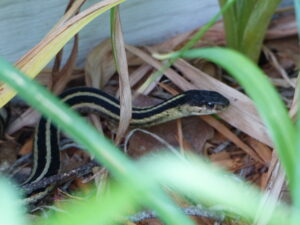
Garter snakes like cool, shady places to wait for a meal.
Just over a year and a half ago, we moved from a home with a suburban postage-stamp-sized yard with little wildlife into a home with a large yard that backs up to a sizable park. Each season we have discovered something new about our new urban “wilderness”. Last spring it was how to identify (and avoid) poison ivy. This spring the theme seems to be reptiles! Earlier this spring I became acquainted with our resident garter snake. Most often it spent time in our vegetable garden but occasionally sunned itself near where I was working in the yard. Though I am not comfortable around snakes I was glad to see him/her – to me a symbol of more abundant life.
How the Adventure Began
Thursday, May 6th seemed like any other lovely spring day. I took myself outside to walk around the gardens and see what was coming up. I walked around to the front of the house to check on hydrangeas I had planted last spring. I had wrapped them in bird netting last year thinking to keep deer from nibbling the tender shoots. To my dismay, I discovered that our resident garter snake had become entangled in the netting, and even worse a much larger snake had also found its way into netting nearby. To my uneducated eyes, this snake looked like a small rattlesnake with a brownish diamond pattern. I was almost relieved that it appeared to be dead. But I knew I needed to rescue my garter snake friend. I was afraid to do this myself – afraid of getting bitten mostly.
So, I started to call and text everyone I could think of to rescue this snake – and me! My husband who was in a meeting, the nature center, DNR. But, alas, I soon figured out I was going to have to tackle this myself if I wanted the snake to survive. So off to Google I went.
Google To The Rescue!
The snakes had netting in their mouths and wrapped around their bodies, multiple times. Google informed me I would need to gently restrain the snake and use nail scissors to cut it free. So, I put on gardening gloves, found a stick with a small fork to hold the snake’s head, and armed myself with nail scissors. Probably more to calm myself, I talked to my little friend while I cut away the netting. Success! After I freed the garter snake I went inside for a moment.
-
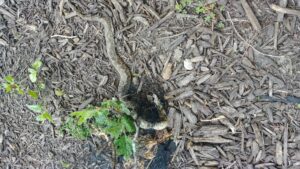
-
Netting gets caught in the snake’s scales when it tries to back out of the netting.
-
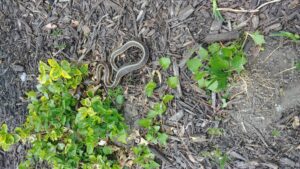
-
This snake slithered off when freed.
Rounds Two and Three
When I came back out – no lie – he/she had found its way into another piece of netting. So, round two – gloves, stick, and scissors. It was clear I needed to remove every shred of that darn bird netting to make sure it would not harm any other creatures. As I was clearing away the netting, I discovered the second snake was in fact alive. Now I had to save it, too! So round three – gloves, stick, and scissors, and the second snake was free. I later learned this is a fox snake.
All Is Well That Ends Well
I haven’t seen them since but I surely hope they are safe, well, and still visiting our yard.
by Winding Pathways | Jun 17, 2021 | (Sub)Urban Homesteading, Pests
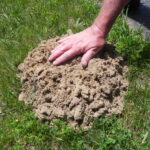
Moles sometimes push up excess dirt.
It’s that season again. Recently we spotted a symmetric dirt cone poking up in our lawn. Fortunately, it wasn’t an early-stage volcano about to erupt. Rather, a mole pushed dirt out of the way so it could continue tunneling.
People hate moles for forming similar dirt piles and their humped tunnels that lawnmower blades sometimes catch. Here’s some basic mole information to help change perspective from a “problem” to a resource and “radical welcoming”.
A Mole Primer
Moles are small mammals of several species that live across North America, Asia, and Europe. They make their living tunneling through the earth to find earthworms and other invertebrates to eat. Contrary to popular belief moles don’t eat plants or roots. They make two types of tunnels. One is fairly deep and is a mole’s highway. It’s for transportation. The other is the familiar humped tunnel moles create to find food that usually is just below the soil surface. Every once in a while, a tunneling mole needs to get rid of some dirt, so they push it to the surface, creating a molehill.
Mole or Gopher?
People confuse moles with gophers. Both are small tunneling animals, but they are very different in these ways:
- Moles eat invertebrates, not plants. Gophers eat plants and roots.
- Moles are most common in moist shady soil and suburban yards. Gophers are more common in open sunny areas, like pastures, and rarely enter suburbia.
- Moles create symmetric hills of dirt. Gophers make elliptical-shaped mounds.
- Mole populations are usually small, while there may be many gophers living in an area.
By softening and aerating the soil both types of animals promote long-term soil health. Often an area bordering a mole tunnel will have the greenest grass in the lawn, for example.
Killing Moles
Mole dislike is so intense that many people work hard to kill any that dare tunnel in their yard. Here are two common mole weapons and why we don’t use them:
- Plunge-type traps impale a hapless mole. We worry that a neighborhood child or someone’s pet could be speared by one of these traps, which also are cruel.
- Poison peanuts are sold in garden stores. The package may say the peanuts will kill moles……and they will if you can get a mole to eat one, but remember that moles eat worms and insects, not peanuts or plants. A peanut is a plant. So people who buy poisoned peanuts are wasting their money and poisoning critters that may eat the poisoned peanut. Like a favorite, curious dog.
What We Do with Moles at Winding Pathways
We view our moles as another interesting and beneficial animal that shares our yard. Yup, mole tunnels kill a strip of grass in the short term, but in the long term, mole activity improves the soil. Worms and most other invertebrates contribute to soil health, so we know if we have moles, we have a healthy lawn.
What to Do About Moles
There are two ways to deal with moles. First, a homeowner can set traps and poison and attempt to kill beneficial animals. Second, forget trying to “get rid” of moles. Instead, just tamp down their tunnels before mowing, and don’t worry about them.
We follow the second.
by Winding Pathways | Jun 10, 2021 | (Sub)Urban Homesteading, Foraging
For years we’ve added wild foraged plants to our diet. They’re free, available, often delicious, and give us the satisfaction of knowing that we can find food close to home.
After years of foraging and trying many wild foods, we now place them into three categories:
- Common, easily gathered and prepared, and tasty.
- Tasty plants but tedious to gather and prepare. Often we just don’t have the patience and time to gather and cook them.
- Ones that are difficult and time-consuming to gather and prepare, and are not especially tasty. These would be worthy food in an emergency but not normally worth the time and effort to gather and prepare.
We concentrate on the first category and one of our favorites is lambsquarters. It’s common just about everywhere. We’ve spotted it beside urban sidewalks, on the edge of farm fields, and in nearly every garden. The plant springs up like magic between rows of vegetables, and too often the gardener rips or hoes them out as weeds. It used to have more respect here. People in some countries still honor and harvest lambsqurter.
Easy Peasy Lambsquarter
Lambsquarters are as delicious as any vegetable we plant in our garden. We don’t need to buy seeds and plant them. They just appear like magic and grow fast as soon as the weather warms. We begin eating them about bean and pumpkin planting time.
Lambsquarters are sometimes called pigweed, goosefoot, wild spinach, or wild beet. They are an amaranth and often grow in large clumps. An easy way to identify them is to examine the top of young plants and the bottom side of leaves. They look white, and drops of water readily slide off.
Like most garden and wild greens, lambsquarters are best harvested when the leaves are new and small. Big summer leaves become tough and bitter. To speed up gathering we sometimes use a big pair of garden scissors to snip them off. Then we thoroughly rinse them to wash off any grit.
Young lambsquarter leaves can be added to salads, but we usually steam them for a few minutes. They’re delicious with a touch of melted butter.
-
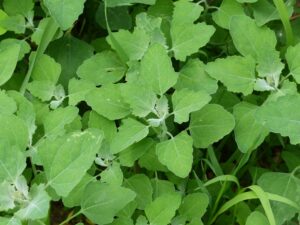
-
A prolific edible.
-
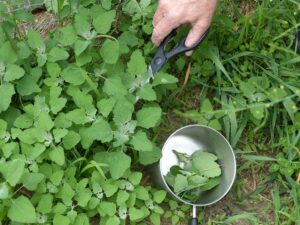
-
We use scissors to snip the tender lambsquarter leaves.
Beware: Before we eat any wild plant new to us we do the following:
- Positively Identify the plant from at least two sources. For example, we confirm identification from any combination of wild food books, credible Internet sites, or knowledge gained first hand from a wild food expert.
- Avoid collecting plants that may be contaminated by farm or lawn chemicals, car fumes, or animal feces or urine.
- Thoroughly wash the plants two or three times.
- Follow cooking or eating instructions found in foraging books or credible Internet sites.
- Eat sparingly the first time. A plant may be perfectly edible for most people but others could be allergic to it. Assuming there’s no digestive problem or adverse reaction after eating a small taste we then enjoy larger servings.
Lambsquarters are delicious, prolific, and are ready to pick all summer. We add them to our meals often. This addition of a nutritious food helps us be less dependent upon the grocery store for our dinner.
by Winding Pathways | May 6, 2021 | (Sub)Urban Homesteading, Flowers/Grasses, Garden/Yard
Springtime on the Prairie
This spring we anxiously await the emergence of prairie flowers in an area that had been traditional lawn. This is a periodic continuing blog about the process of converting the lawn to a prairie. We’ll have a couple more updates this season. Here’s what we did to prepare for this year’s growth:
2020
April and May 2020: Sustainable Landscape Solutions sprayed the lawn twice to kill existing grass plants, which were nearly entirely exotic species.
May 2020: Sustainable Landscape Solutions tilled the now dead turf.
May 2020: Rich and Marion broadcast a diverse array of seeds that included 82 wildflower species and a few lower-growing types of priaire grasses.
August 2020: A derecho felled three trees west of the site and a few to the east. This increases the sun on the new prairie. That’s good.
By mid-summer, a thick growth of annual crabgrass covered the site with only partridge pea obvious from our seeds.
November 2020: The crabgrass was dead and dry, so we burned it on the same day we burned our existing prairies. The fire was slow and low.
2021
Winter 2020/21: Heavy snow covered the site for much of the winter. When it melted, we discovered mostly bare soil with few surviving exotic grasses present. This is perfect, as native seeds will respond to warm temperatures.
April 2021: Small prairie forbs are emerging. Among the many spring greens poking up, we can identify Black-Eyed Susans, Mountain Mint, and Partridge Pea. Only a few of the 82 species we cast out. Part of the fun of restoring prairie is learning what the emerging plants are.
-

-
Part of the fun of establishing prairies is learning what the plants are.
-
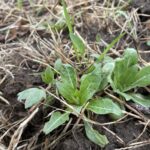
-
Possibly shooting star?
-
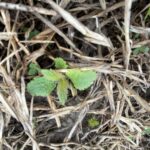
-
Poking through
We’ll update with a Prairie Renaissance Blog as the natives get going.
by Winding Pathways | Apr 29, 2021 | (Sub)Urban Homesteading, Energy Efficiency
Many people dread the arrival of their monthly electric bill. Not us.
We recently received a $13.38 monthly bill from Alliant Energy for electricity used in March. A day later Enphase Energy emailed us our March photovoltaic production. That’s correct. Thirteen dollars and thirty-eight cents.
Our bill is about 1/10th the national average homeowner’s bill and is small thanks to three actions. Here’s what we do:
- Shut “it” off: We are stingy on both money and wasteful appliances being on. If we’re not using lights, computers, the television, toaster, radon machine (that we turn off when we happen to be gone), or other electricity consumers we turn them off. We never leave outside lights on all night. They are wasteful, advertise where you live, and diminish the night sky. The latter we are learning is more important to humans than realized.
- Embrace efficiency: Our house is almost entirely lit by LED bulbs with a few fluorescents and no incandescents. LEDs use only a tiny bit of electricity to provide outstanding light, and when we purchase appliances, we choose those most efficient.
- Installed photovoltaics. We installed a small system four years ago and reaped federal and state tax credits. As soon as the system went active our bills plummeted.
- Of course, in order to do the above, one has to plan and save money by doing the simple acts of turning off electric sources and long-term spend on only what you truly need.

On sunny days solar powers our energy needs.
Every month Enphase Energy emails us a report of our prior months’ electric production. March 2021 was mostly sunny and clear and our system produced 283 kilowatts. February was a dark winter month and our system was blanketed with snow. The system only made 76 KWH. However, as days lengthen our nine solar panels will produce ever more electricity, keeping our monthly bill low.
by Winding Pathways | Apr 22, 2021 | (Sub)Urban Homesteading, Garden/Yard, Mammals
Readers’ Adventures With Pogo Possum
The Pogo Possum adventures really resonated with people. So, Winding Pathways is sharing some of these.
SA enthusiastically wrote: I love that you named him Pogo. “We have met the enemy and he is us.”
JH has a thoughtful perspective: Pogo certainly has some caring humans. I agree with you that they are very interesting critters. I just wish the rest of the world that zips by in four-wheeled contraptions would think likewise instead of hitting them.
MH shared: We found one in our house. I was gone for a week. I like fresh air at night so left an outside door open that had a small hole in the screen my husband called to say there was a pile of poop in the living room. On investigation, he found one hidden behind our TV console. We guessed he came in through the screen.
From Colleges to Communities Pogo Resonates
MM told about Kirkwood Community College’s adventures: While at Kirkwood, when the original greenhouses were attached to my Grounds Department building, we found a female, with babies, living in the north greenhouse. Once Stacey, the students, and my crew understood the benefits of having this tenant, we left her and her babies alone. Occasionally, one of the babies would explore the greenhouse, but with a little coaxing, he or she would return to the nest. I was fortunate to see the mother finally take her young out of the greenhouse, exposing them to their new life outside of the greenhouse environment. I don’t know if it was the same opossum or one of the babies, but one of them must have been paying rent, as each year we welcomed a resident, with babies. I do miss the interaction and YES, I was providing a bit of food, as well as the occasional rat or mouse courtesy of the raptor building behind our greenhouses.
SR What a lovely story about Pogo, your cozy little possum neighbor! Friends not far from you have another small one who scoots on into the garage for cat food whenever the door is open. One day she found it curled up for a daytime nap inside the watering can in her garage. What a handy handle to walk it on back outside. The sleepy little creature just looked up blinking its eyes and smacking its possum smile. Then it ambled right out of the watering can once she put it down on its side. I dare anyone to try this with a raccoon or even a groundhog.
AF Too cute to pass up commenting on. We too have a possum neighbor.
PL succinctly wrote: Love Pogo!!!
Thank you, all for sharing your Pogo adventures! This looks like a periodic series on an ancient, maligned and interesting resident among us.
-
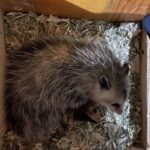
-
After eating an egg, Pogo took a nap.
-
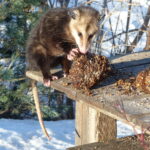
-
Possums have agile hands.
-
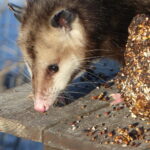
-
On a cold winter day Pogo appeared.
Thank you, all for sharing your Pogo adventures! This looks like a periodic series on an ancient, maligned, and interesting resident among us.













